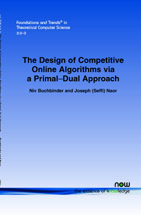The Design of Competitive Online Algorithms via a Primal–Dual Approach
By Niv Buchbinder, Computer Science Department, Technion — Israel Institute of Technology, Israel, nivb@cs.technion.ac.il | Joseph (Seffi) Naor, Computer Science Department, Technion — Israel Institute of Technology, Israel, naor@cs.technion.ac.il
Abstract
The primal–dual method is a powerful algorithmic technique that has proved to be extremely useful for a wide variety of problems in the area of approximation algorithms for NP-hard problems. The method has its origins in the realm of exact algorithms, e.g., for matching and network flow. In the area of approximation algorithms, the primal–dual method has emerged as an important unifying design methodology, starting from the seminal work of Goemans and Williamson [60].
We show in this survey how to extend the primal–dual method to the setting of online algorithms, and show its applicability to a wide variety of fundamental problems. Among the online problems that we consider here are the weighted caching problem, generalized caching, the set-cover problem, several graph optimization problems, routing, load balancing, and the problem of allocating ad-auctions. We also show that classic online problems such as the ski rental problem and the dynamic TCP-acknowledgement problem can be solved optimally using a simple primal–dual approach.
The primal–dual method has several advantages over existing methods. First, it provides a general recipe for the design and analysis of online algorithms. The linear programming formulation helps detecting the difficulties of the online problem, and the analysis of the competitive ratio is direct, without a potential function appearing "out of nowhere." Finally, since the analysis is done via duality, the competitiveness of the online algorithm is with respect to an optimal fractional solution, which can be advantageous in certain scenarios.
The Design of Competitive Online Algorithms via a Primal-Dual Approach
The Design of Competitive Online Algorithms via a Primal-Dual Approach extends the primal-dual method to the setting of online algorithms, and shows its applicability to a wide variety of fundamental problems. Among the online problems considered are the weighted caching problem, generalized caching, the set-cover problem, several graph optimization problems, routing, load balancing, and the problem of allocating ad-auctions. There is also an illustration of how classic online problems such as the ski rental problem and the dynamic TCP-acknowledgement problem can be solved optimally using a simple primal-dual approach. The Design of Competitive Online Algorithms via a Primal-Dual Approach is an invaluable reference for anyone working in the area of computational theory, and especially those interested in exploring online scenarios that can benefit from the primal-dual framework.
